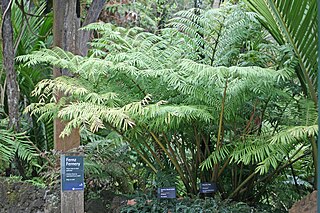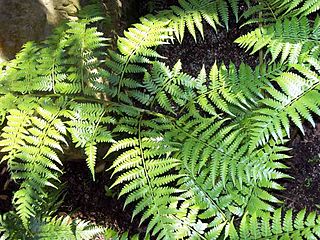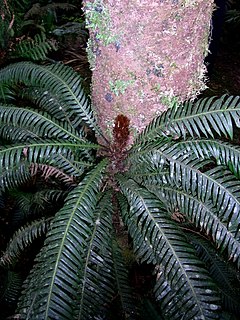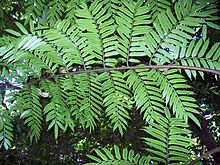
Lord Howe Island is an irregularly crescent-shaped volcanic remnant in the Tasman Sea between Australia and New Zealand, part of the Australian state of New South Wales. It lies 600 km (320 nmi) directly east of mainland Port Macquarie, 780 km (420 nmi) northeast of Sydney, and about 900 km (490 nmi) southwest of Norfolk Island. It is about 10 km (6.2 mi) long and between 0.3 and 2.0 km wide with an area of 14.55 km2, though just 3.98 km2 of that comprise the low-lying developed part of the island.

Ball's Pyramid is an erosional remnant of a shield volcano and caldera lying 20 kilometres (12 mi) southeast of Lord Howe Island in the Pacific Ocean. It is 562 metres (1,844 ft) high, while measuring 1,100 metres (3,609 ft) in length and only 300 metres (984 ft) across, making it the tallest volcanic stack in the world. Ball's Pyramid is part of the Lord Howe Island Marine Park in Australia and is over 643 kilometres (400 mi) northeast of Sydney, New South Wales.

Alsophila brevipinna, synonym Cyathea brevipinna, is a species of tree fern endemic to the higher parts of Mount Gower on Lord Howe Island, where it grows in exposed areas at an altitude of about 790 m. The trunk is erect and may reach 3 m in height. It is often covered with reddish brown scales and stipe bases. This species may produce stolons at ground level. Fronds are tripinnate, densely crowded, and up to about 3 m long. The stipe is brown and sometimes warty after scales fall off. The scales are long, glossy dark brown, with a distinctly narrow apex and fragile paler edges. Sori are attached to deeply divided fertile pinnules that may uncurl over the sori. Indusia are firm and large. A. brevipinna is a stunted plant with short pinnae.

Ptisana is a genus in the eusporangiate fern family Marattiaceae, comprising species historically treated in the genus Marattia. The establishment of this genus follows the 2008 work by Andrew G. Murdock, which supported recognition of this group on the basis of genetic analysis and morphology. Ptisana can be distinguished from Marattia by the presence of distinct sutures at the point of leaflet attachment, deeply cut synangia, and the absence of labiate sporangial apertures. The name Ptisana is derived from the Latin word for pearl barley, an allusion to the shape of the synangia.

Hymenophyllum moorei is a rare species of filmy fern in the family Hymenophyllaceae. It is endemic to the high cloud forest at Mount Gower and Mount Lidgbird at Lord Howe Island. A small epiphytic fern found usually on tree trunks and fallen logs.

Melaleuca howeana, commonly known as tea tree, is a plant in the myrtle family, Myrtaceae and is endemic to the Lord Howe Island group, 600 km (400 mi) off the east coast of Australia. It is common in exposed areas, on cliffs and ridges, occasionally forming pure stands. Its closest mainland relative is Melaleuca ericifolia.

Diplazium melanochlamys is a ground fern only found on Lord Howe Island in the relatively remote Pacific Ocean between Australia and New Zealand. A common plant growing in forest. Most often seen on the southern half of the island. It can be seen between sea level and the summits of Mount Gower and Mount Lidgbird.

Dryococelus australis, commonly known as the Lord Howe Island stick insect or tree lobster, is a species of stick insect that lives on the Lord Howe Island Group. It is the only member of the monotypic genus Dryococelus and was thought to be extinct by 1920, only to be rediscovered in 2001. It is extirpated in its largest former habitat, Lord Howe Island, and has been called "the rarest insect in the world", as the rediscovered population consisted of 24 individuals living on the small islet of Ball's Pyramid.

Pouteria howeana, commonly known as axe-handle wood, is a species of small tree in the family Sapotaceae. It is found in the lowlands of Lord Howe Island, and early settlers used its hard wood to make axes.

Parsonsia howeana is a vigorous twining vine of the family Apocynaceae. It is endemic to Australia’s subtropical Lord Howe Island in the Tasman Sea. It is common in the island's forests at low elevations.

Lomaridium contiguum, synonym Blechnum contiguum, is a fern in the family Blechnaceae. The specific epithet refers to the contiguous lobes of the fronds.

Cranfillia fullagari, synonym Blechnum fullagarii, is a fern in the family Blechnaceae. The specific epithet honours James Fullagar, who collected plants on Lord Howe Island for the Royal Botanic Gardens, Melbourne.
Cranfillia geniculata, synonym Blechnum geniculatum, is a fern in the family Blechnaceae. The specific epithet refers to the geniculate base of the sterile fronds.

Parablechnum howeanum, synonym Blechnum howeanum, is a fern in the family Blechnaceae. The specific epithet refers to the locality to which it is endemic.

Cyathea howeana is a fern in the family Cyatheaceae. The specific epithet refers to Lord Howe Island, the locality in Australia to which it is endemic.
Polystichum moorei is a fern in the family Dryopteridaceae. The specific epithet honours Charles Moore, Director of the Royal Botanic Gardens, Sydney, from 1848 to 1896, who collected plants on Lord Howe Island in 1869.

Polystichum whiteleggei is a fern in the family Dryopteridaceae. A former common name was heavy fern, alluding to the weight of one of the large, thick textured, fronds when fully developed. The specific epithet honours Thomas Whitelegge (1850–1927) of the Australian Museum, who collected zoological specimens on Lord Howe Island in 1887, who first noticed the fern's distinctiveness.

Grammitis nudicarpa is a fern in the family Polypodiaceae.

Leptopteris moorei is a fern in the family Osmundaceae. The specific epithet honours Charles Moore, Director of the Royal Botanic Gardens in Sydney from 1849 to 1896, who collected plants on Lord Howe Island in 1869.
Gahnia howeana is a flowering plant in the sedge family. The specific epithet refers to Lord Howe Island, where it is found. It was formerly lumped with Gahnia xanthocarpa, which is now considered to be endemic to New Zealand.

















